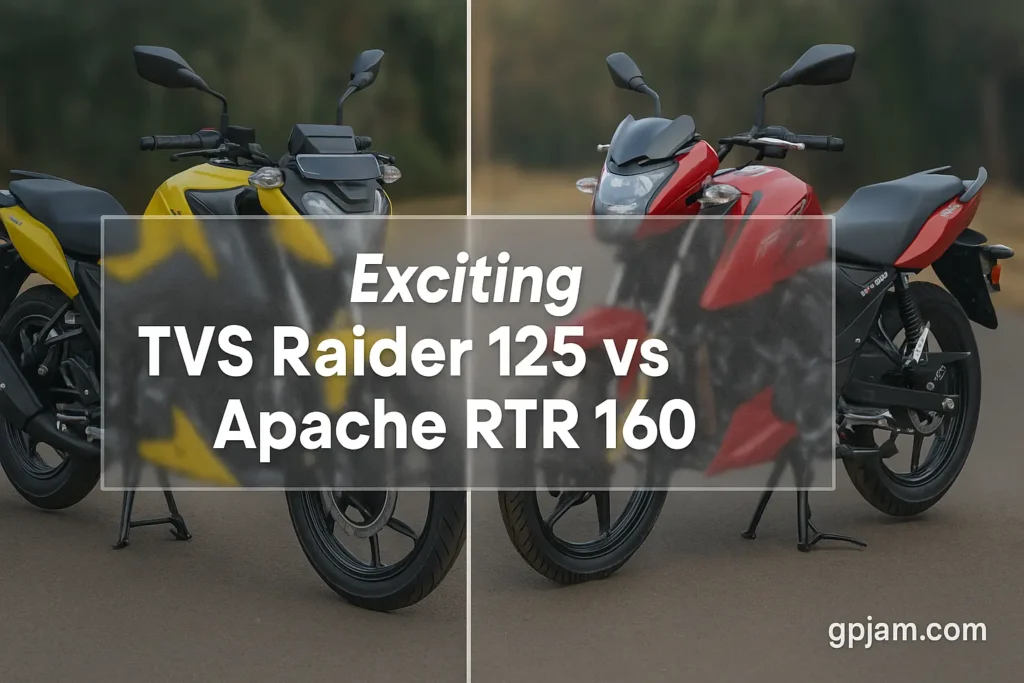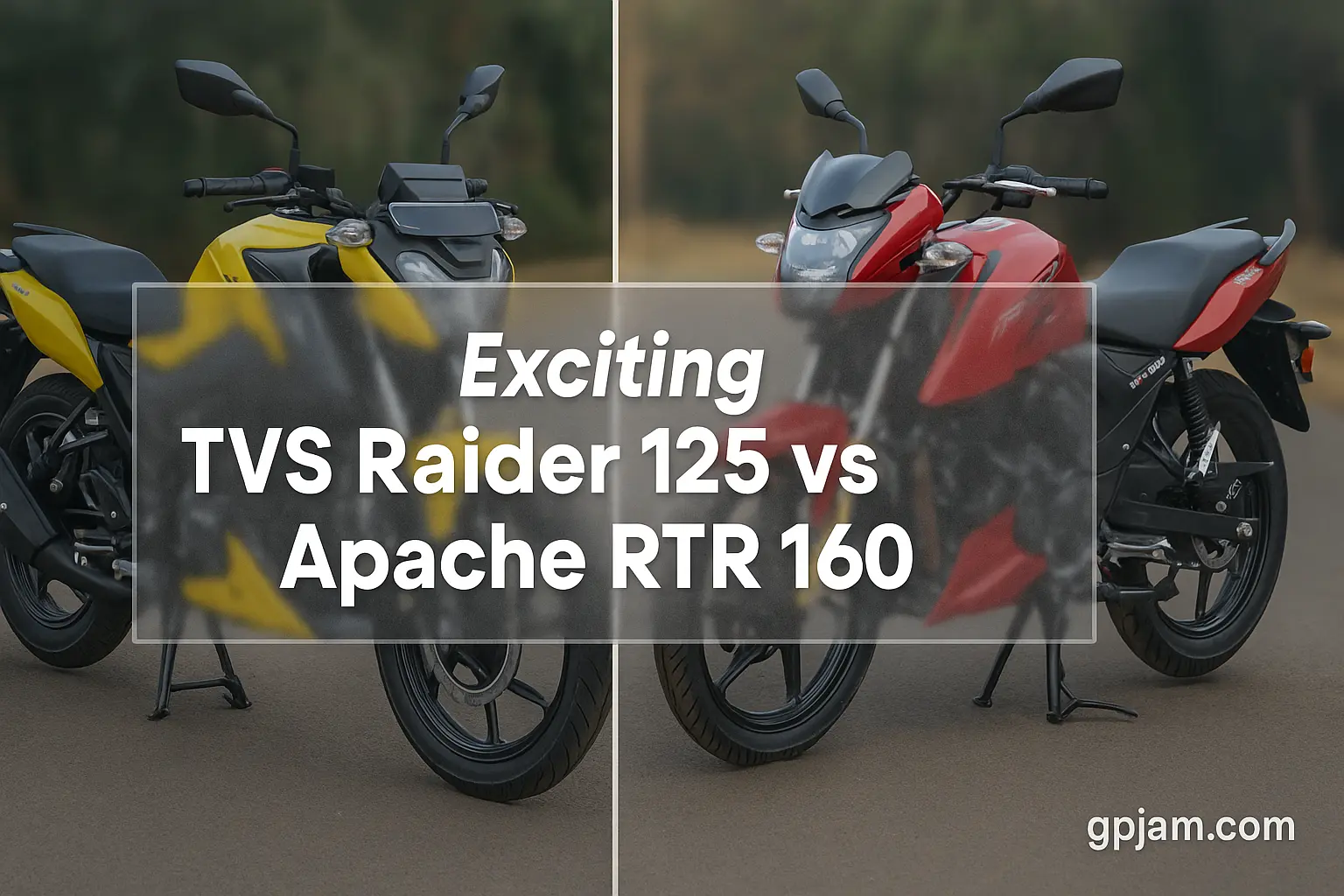Looking for a performance-packed bike in the 125cc to 160cc segment? You’ve probably come across the TVS Raider 125 and the TVS Apache RTR 160. Both are standout machines from TVS Motor Company, offering a unique blend of performance, style, and features. But which one truly deserves your attention? In this comprehensive comparison of TVS Raider 125 vs Apache RTR 160, we dive deep into specs, top speed, mileage, brake systems, and more.
Whether you’re a daily commuter, a college student, or a bike enthusiast, this guide will help you choose the right bike that balances fuel economy, sporty aesthetics, and ride comfort.
What Makes TVS Raider 125 a Game-Changer in the 125cc Segment?
The TVS Raider 125 has revolutionized the 125cc segment by combining aggressive design, excellent mileage, and futuristic features like a TFT display and voice assist. The Raider 125 is not your average commuter bike—it’s a stylish, tech-savvy ride built for the young generation.
Powered by a 124.8cc single-cylinder engine, the TVS Raider 125 delivers a peppy 11.38 bhp and 11.2 Nm of torque, mated to a smooth 5-speed manual gearbox. What truly sets the Raider apart is its sporty stance, split seat, LED DRLs, and ride modes.
Key features:
- TFT display with SmartXonnect (top variant)
- USB charger, voice assist, and notification alerts
- Excellent fuel economy of 56-60 kmpl
- Lightweight at just 123kg
TVS has made sure the Raider isn’t just about looks; the performance matches its bold aesthetics. For city rides and occasional long trips, it checks all the boxes.

Why Is Apache RTR 160 Still a Top Performer Among Street Bikes?
The TVS Apache RTR 160 is part of the legendary Apache series. Known for its track-tested performance, this model carries forward the legacy with a BS6-compliant 159.7cc engine that produces 15.82 bhp and 13.85 Nm of torque.
The TVS Apache RTR lineup is famous for its aggressive styling, digital instrument cluster, and superior handling, especially with its rear mono-shock and telescopic front forks. The RTR 160 is ideal for riders looking for power-packed performance without compromising on mileage.
Highlights:
- Top speed of 114 km/h
- Offers ride modes and SmartXonnect in higher trims
- Mileage of 45-50 kmpl (decent for a 160cc)
- Available in 6 variants and vibrant color options
The Apache RTR 160 offers the thrill of a streetfighter while being practical enough for daily use.
TVS Raider 125 vs TVS Apache RTR 160: Which Offers Better Mileage?
Mileage is a crucial factor for most Indian riders. Here’s how these two perform in real-world conditions:
| Bike | Mileage (kmpl) |
|---|---|
| TVS Raider 125 | 56 – 60 |
| Apache RTR 160 | 45 – 50 |
Clearly, the TVS Raider 125 offers excellent mileage, making it ideal for daily commutes and city rides. The Apache RTR 160, with a bigger engine, trades a bit of mileage for more power. Choose based on your priorities—fuel economy or performance.
What Are the Key Differences in Design and Build Quality?
Both bikes look stunning, but they cater to different tastes:
- TVS Raider 125: Sporty, youthful, aggressive. Comes with split seat, modern tank design, and LED lighting.
- Apache RTR 160: Muscular, mature, track-inspired. Equipped with aerodynamic tank shrouds and racing graphics.
Both bikes feel sturdy and well-built. However, the Raider feels lighter and more agile due to its 123kg kerb weight, compared to the Apache’s slightly heavier frame.
Which Bike Has the Better Brake and Safety Setup?
Braking is vital, especially in Indian traffic conditions.
- TVS Raider 125: Front disc (240mm) and rear drum in standard variants. Equipped with combined braking system (CBS).
- Apache RTR 160: Offers front and rear disc brakes with single-channel ABS.
Winner? The Apache RTR 160, thanks to the better braking system and ABS which adds an extra layer of safety.
What’s the Price of TVS Raider 125 vs Apache RTR 160?
Let’s compare the ex-showroom price in Delhi:
| Bike | Ex-showroom Price (Approx.) |
| TVS Raider 125 | ₹92,000 – ₹1.03 lakh |
| Apache RTR 160 | ₹1.20 lakh – ₹1.30 lakh |
If you’re on a budget, the Raider 125 price clearly makes it a value-for-money option. But if performance and additional features are your priority, the Apache 160 justifies its price.
Fuel Tank Capacity, Weight, and Dimensions Compared
| Specification | TVS Raider 125 | Apache RTR 160 |
| Fuel Tank Capacity | 10 litres | 12 litres |
| Weight | 123kg | 139kg |
| Seat Height | 780mm | 790mm |
The Raider is more commuter-friendly due to its lower seat height and light weight. If you’re a beginner or a city rider, the Raider feels more manageable.
TVS Raider 125 vs Apache RTR 160 4V: Should You Consider the 4V Variant?
The Apache RTR 160 4V takes things up a notch with increased power output (17.55 bhp), improved torque, and ride modes for Urban, Rain, and Sport.
If you’re torn between a Raider 125 vs TVS Apache RTR 160 4V, ask yourself: Do you want daily utility with a dash of style or do you crave high-performance thrill? The 4V is better for highway rides, while the Raider is perfect for everyday city use.
How Does TVS Raider 125 Compare to Honda SP 125?
If you’re looking into the 125cc motorcycle segment, chances are you’ve also considered the Honda SP 125. Here’s a quick glance:
| Feature | TVS Raider 125 | Honda SP 125 |
| Power | 11.38 bhp | 10.8 bhp |
| Torque | 11.2 Nm | 10.9 Nm |
| Tech | TFT display, SmartXonnect | Digital console only |
| Mileage | 56-60 kmpl | 55-60 kmpl |
Verdict: The Raider 125 wins in terms of tech, styling, and ride experience. It’s the more engaging bike among the two.
Explore TVS Lineup: Should You Consider Other Models Like Ntorq, RR 310, or RTR 200 4V?
TVS isn’t just about Raider and Apache. If you’re still unsure, here’s a quick look at other offerings:
- TVS Ntorq: Sporty scooter with voice assist, navigation, and SmartXonnect.
- TVS Apache RTR 200 4V: More powerful, perfect for sporty riders.
- TVS RR 310: Premium fully-faired sports bike in partnership with BMW.
If budget allows, the RTR 200 4V is a compelling middle ground with ride modes, better torque, and an advanced braking system.
Final Verdict: Raider 125 vs Apache RTR 160 – Which One’s for You?
So, which bike wins the Raider 125 vs TVS Apache battle? It ultimately comes down to your riding needs and preferences. If you prioritize excellent mileage, have a budget under 1 lakh, and mainly ride in city traffic, then the TVS Raider 125 is the perfect companion. It’s also a tech lover’s delight, offering SmartXonnect, a TFT display, and a handy USB charger.
On the other hand, if you seek more power and a higher top speed, frequently hit the highways, and prefer added safety with disc brakes and ABS, then the Apache RTR 160 is your ideal choice. Plus, if you’re a fan of the bold, aggressive design language of the Apache series, this bike will absolutely resonate with your personality.
FAQ
What is the real-world mileage of TVS Apache RTR 160?
Expect around 45-50 kmpl depending on traffic and riding style.
How many colors is the Raider 125 available in?
The Raider 125 is available in 2 colours: Fiery Yellow and Wicked Black, with striking body graphics.
Is the price of TVS Raider 125 worth it?
Absolutely. With all the features it packs, it offers excellent value-for-money in the 125cc segment.
Is TVS Raider 125 good for long rides?
Yes, it’s comfortable for short to medium-long rides thanks to its split seat, upright position, and decent torque. However, for pure touring, the Apache is better.
Which is better for a beginner: Raider or Apache?
The Raider is lighter and easier to handle, making it the better choice for beginners.






